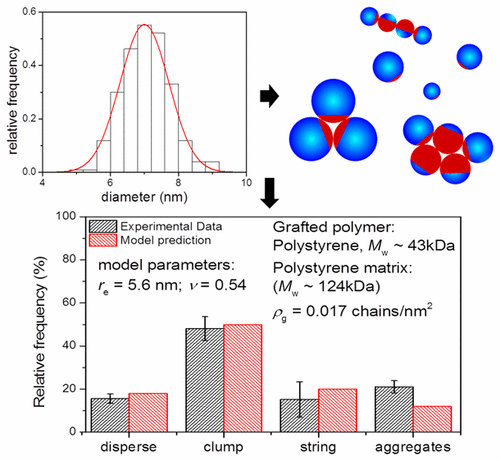当前位置:
X-MOL 学术
›
Macromolecules
›
论文详情
Our official English website, www.x-mol.net, welcomes your
feedback! (Note: you will need to create a separate account there.)
Impact of the Distributions of Core Size and Grafting Density on the Self-Assembly of Polymer Grafted Nanoparticles
Macromolecules ( IF 5.1 ) Pub Date : 2017-09-22 00:00:00 , DOI: 10.1021/acs.macromol.7b01093 Nirmalya Bachhar 1 , Yang Jiao 2 , Makoto Asai 1 , Pinar Akcora 2 , Rajdip Bandyopadhyaya 3 , Sanat K. Kumar 1
Macromolecules ( IF 5.1 ) Pub Date : 2017-09-22 00:00:00 , DOI: 10.1021/acs.macromol.7b01093 Nirmalya Bachhar 1 , Yang Jiao 2 , Makoto Asai 1 , Pinar Akcora 2 , Rajdip Bandyopadhyaya 3 , Sanat K. Kumar 1
Affiliation

|
It is now well-accepted that hydrophilic nanoparticles (NPs) lightly grafted with polymer chains self-assemble into a variety of superstructures when placed in a hydrophobic homopolymer matrix or in a small molecule solvent. Currently, it is thought that a given NP sample should only assemble into one kind of superstructure depending on the relative balance between favorable NP core–core attractions and steric repulsion between grafted polymer chains. Surprisingly, we find that each sample shows the simultaneous formation of a variety of NP-assemblies, e.g., well-dispersed particles, strings, and aggregates. We show through the generalization of a simple geometric model that accounting for the distributions of the NP core size and the number of grafted chains on each NP (which is especially important at low coverages) allows us to quantitatively model the aggregate shape distribution. We conclude that, in contrast to molecular surfactants with well-defined chemistries, the self-assembly of these NP analogues is dominated by such fluctuation effects.
中文翻译:

核心尺寸和接枝密度分布对聚合物接枝纳米粒子自组装的影响
现在已经被公认的是,当将其轻度接枝到聚合物链上的亲水性纳米颗粒(NPs)置于疏水性均聚物基质或小分子溶剂中时,它们会自组装成各种上部结构。目前,据认为,给定的NP样品仅应组装成一种上层建筑,这取决于有利的NP核心-核心吸引力与接枝的聚合物链之间的空间排斥之间的相对平衡。出乎意料的是,我们发现每个样品都显示出同时形成了各种NP组件,例如,分散良好的颗粒,细绳和聚集体。通过简单的几何模型的概括,我们可以说明,考虑到NP核大小的分布以及每个NP上的接枝链数(这在低覆盖率下尤其重要),可以使我们对总体形状分布进行定量建模。我们得出的结论是,与化学成分明确的分子表面活性剂相比,这些NP类似物的自组装受这种波动效应的支配。
更新日期:2017-09-22
中文翻译:

核心尺寸和接枝密度分布对聚合物接枝纳米粒子自组装的影响
现在已经被公认的是,当将其轻度接枝到聚合物链上的亲水性纳米颗粒(NPs)置于疏水性均聚物基质或小分子溶剂中时,它们会自组装成各种上部结构。目前,据认为,给定的NP样品仅应组装成一种上层建筑,这取决于有利的NP核心-核心吸引力与接枝的聚合物链之间的空间排斥之间的相对平衡。出乎意料的是,我们发现每个样品都显示出同时形成了各种NP组件,例如,分散良好的颗粒,细绳和聚集体。通过简单的几何模型的概括,我们可以说明,考虑到NP核大小的分布以及每个NP上的接枝链数(这在低覆盖率下尤其重要),可以使我们对总体形状分布进行定量建模。我们得出的结论是,与化学成分明确的分子表面活性剂相比,这些NP类似物的自组装受这种波动效应的支配。











































 京公网安备 11010802027423号
京公网安备 11010802027423号